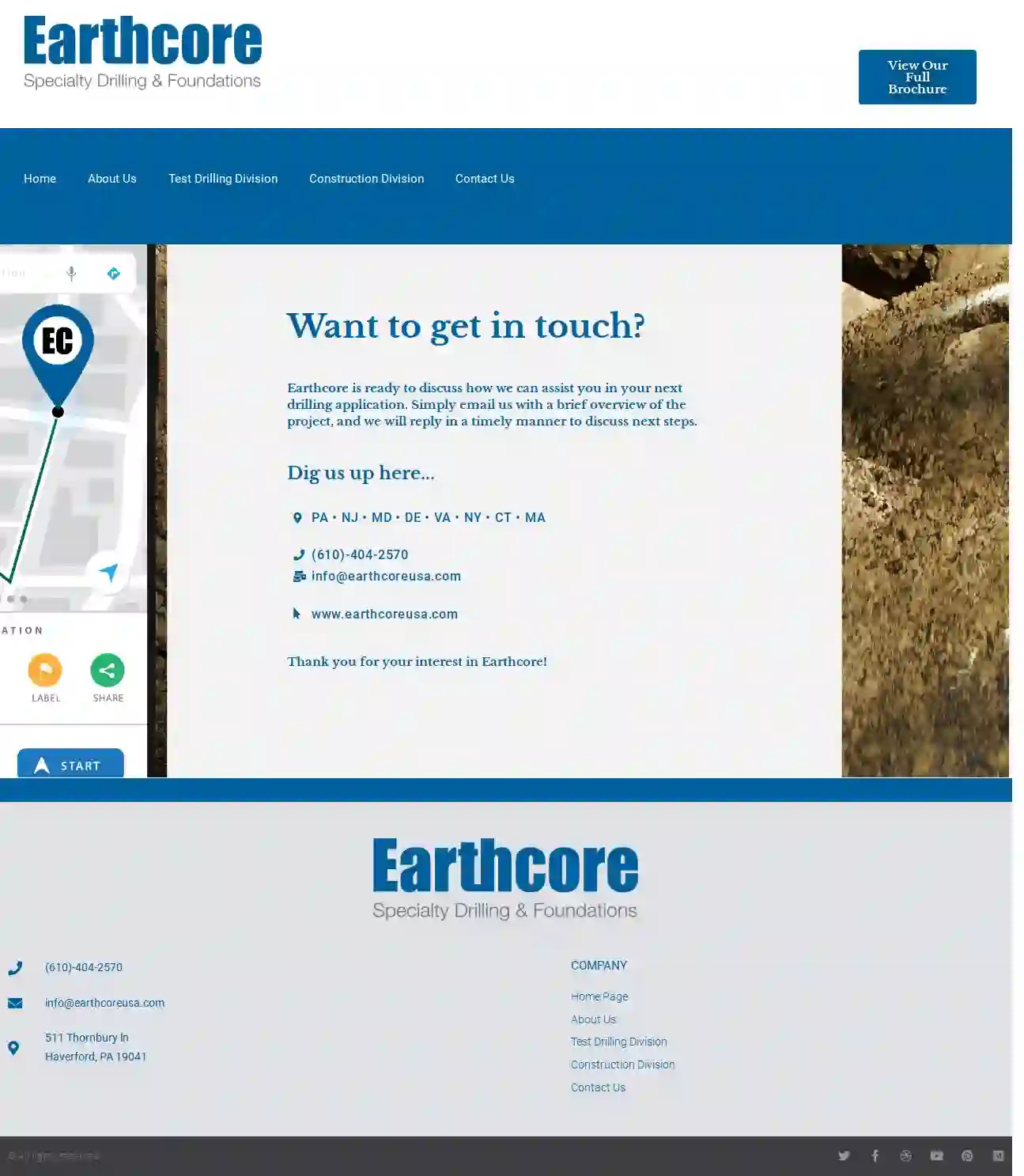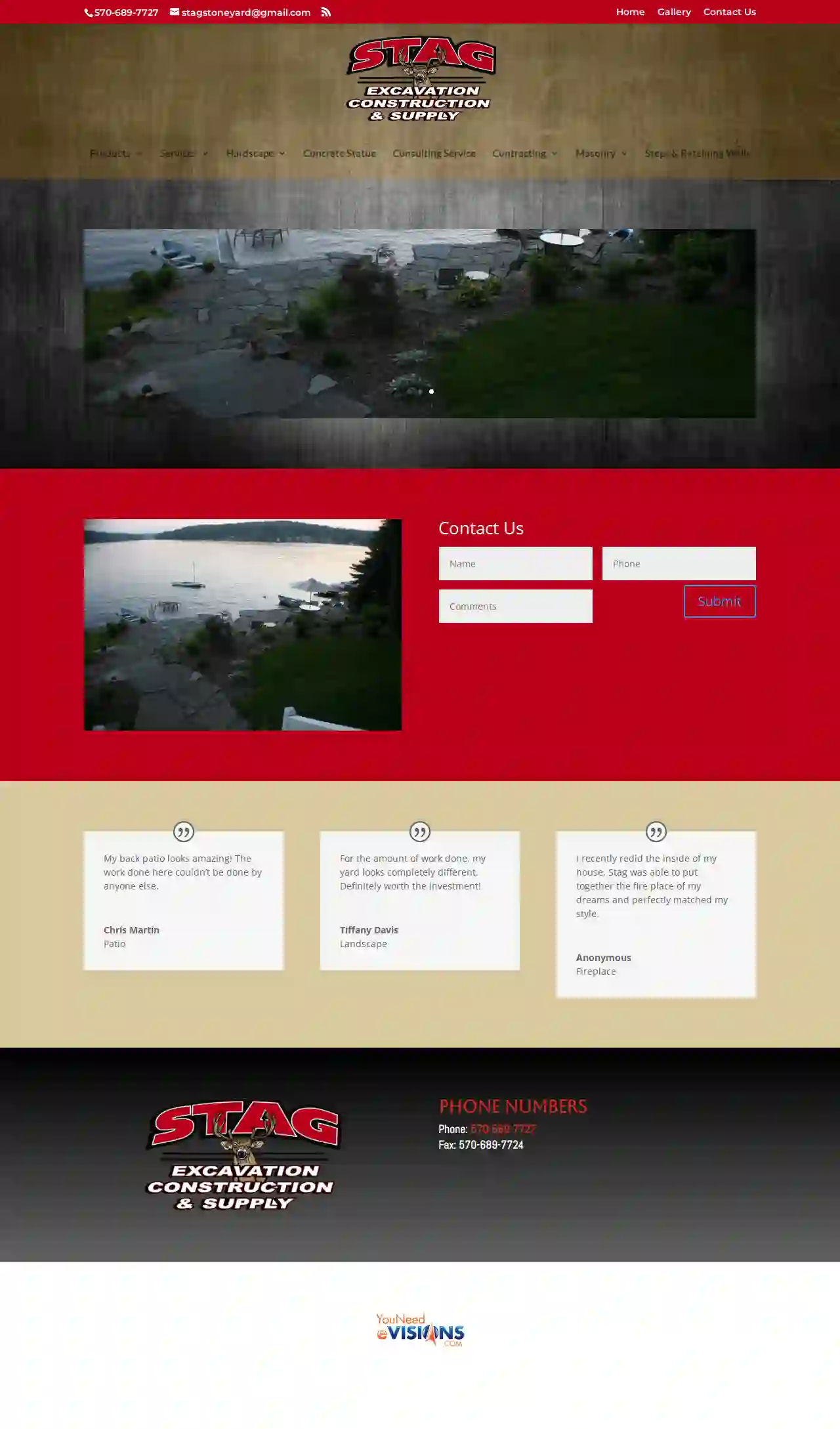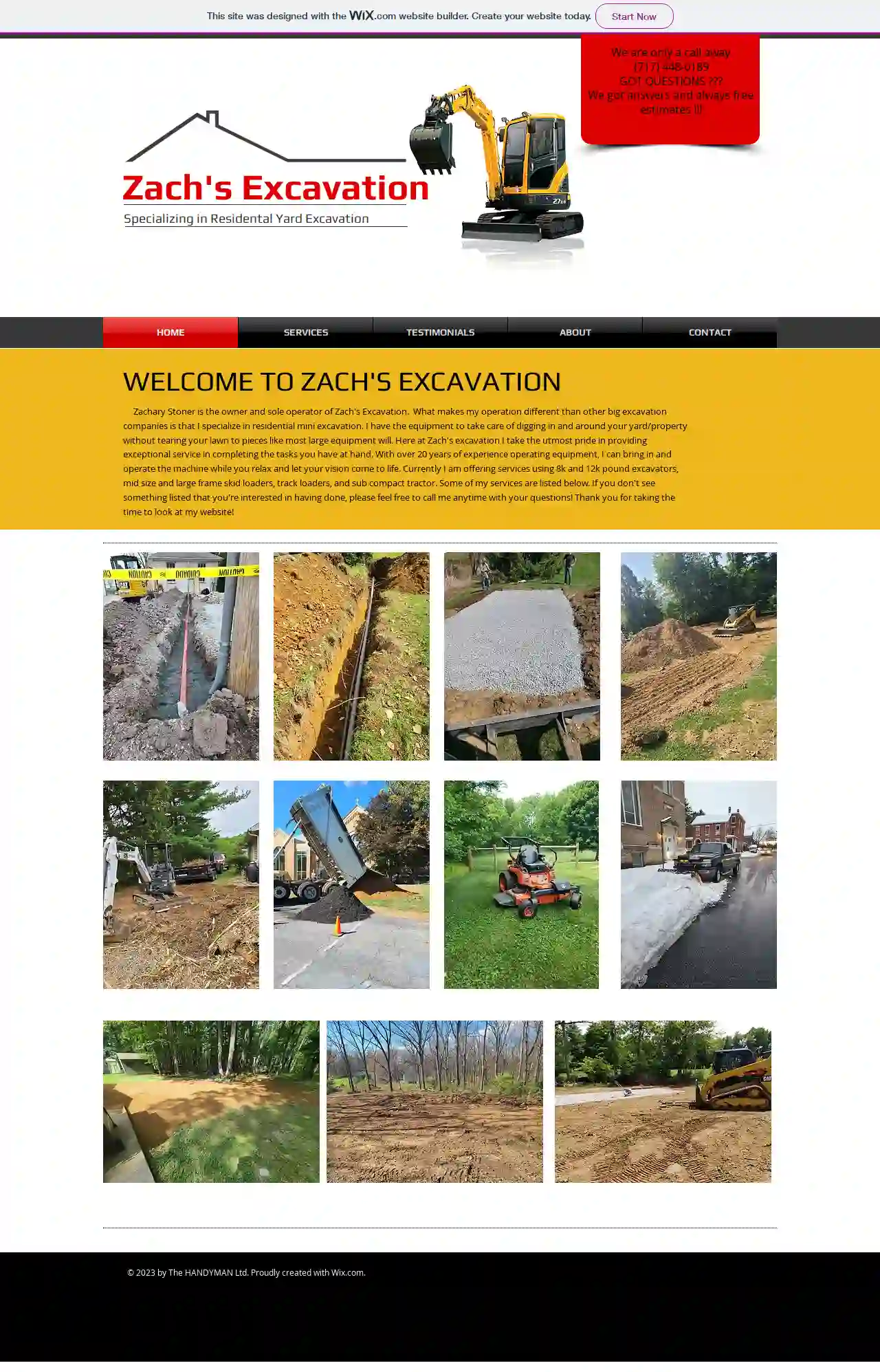Excavation Contractors Rosemont
Top Excavating Contractors in Rosemont
Receive 3 FREE Excavation Services quotes for your project today! Compare profiles, reviews, accreditations, portfolio, etc... and choose the best offer.

Earthcore
11 reviews455 Fairview Chapel Road, Birdsboro, 19508, USFor decades, engineers, contractors, and property owners alike have come to rely on Earthcore as the go-to resource to resolve their toughest drilling and foundation construction challenges. Headquartered in Birdsboro, PA, we deploy our crews across the Northeast and Mid-atlantic regions. With a proven track record of documented safety, certifications, and successful execution, Earthcore brings highly-experienced operators and a large, diverse fleet of powerful rigs to job-sites rapidly to get the job done right. We invite you to do a little digging of your own to learn how Earthcore may be the perfect solution for your project. Be it test borings, soil stabilization, or assistance with specialty foundation construction, we do it all.
- Services
- Why Us?
- Gallery
Get Quote
Stag Excavation Construction & Supply
52 reviewsHamlin, USStag Excavation & Stone Yard Stag Excavation & Stone Yard is a family-owned and operated business serving the Hamlin, PA area. We offer a wide range of services, from excavating and demolition to hardscaping and custom home construction. We are committed to providing our clients with high-quality workmanship and exceptional customer service. Our team of experienced professionals is dedicated to exceeding your expectations and delivering projects on time and within budget. We are proud to be a trusted name in the community and look forward to serving your needs. We are located just outside of Hamlin Corners in Hamlin PA. We offer free estimates on all of our services. Contact us today to schedule a consultation.
- Services
- Why Us?
- Testimonials
- Gallery
Get Quote
Kuharchik Construction
4.428 reviews420 Schooley Ave, Exeter, 18643, USWE ARE KUHARCHIK CONSTRUCTION. Providing superior electrical contracting services throughout Pennsylvania since 1973. We’re local, we’re family owned, we’re union! Kuharchik is your first choice in Electrical Contracting. From Highway Signing & Lighting to Foundation Installation, we take pride in every job that we do.
- Services
- Why Us?
- Gallery
Get Quote
AKO Builders
552 reviews33 Hawley Ave, 33 Hawley Ave Staten Island, New York, Staten Island, 10312, USWelcome to AKO Builders and Home Improvements At AKO Builders and Home Improvements, we provide excellence in customer service and quality workmanship. All our work is guaranteed to last, and we promise only the best in products and services. OUR COMPANY AKO Builders and Home Improvements is a licensed, insured and bonded company located in Staten Island, New York. Our company works in all five boroughs of NYC. learn more PROFESSIONAL STANDARDS Clients always receive clearly detailed project plans, including budget and timeline. OVER 20 YEARS OF EXPERIENCE We are a fully licensed and insured company that combines high quality workmanship, superior knowledge and reasonable prices to provide you with highest quality service that separates us from our competitors. BEST MATERIALS All projects are handled with durable, high quality materials that will serve you for decades.
- Services
- Why Us?
- Testimonials
- Gallery
Get Quote
NYC Excavation Contractor
York, USAbout NYC Excavation Contractor NYC Excavation Contractor is a premier provider of excavation services in New York City. With a dedicated team of professionals and top-of-the-line equipment, we deliver unmatched quality in every project we undertake. Our commitment to excellence has earned us a reputation for delivering exceptional results. From clearing land to precision grading, we have successfully completed numerous projects, exceeding client expectations at every turn. Our Commitment Missions & Values Driven by Purpose Our Mission To provide reliable, efficient, and top-quality excavation services to our clients, ensuring their projects are successful and their visions are brought to life. Core Principles Our Values We uphold integrity, professionalism, and client satisfaction as the cornerstones of our operations, fostering relationships based on trust, transparency, and mutual respect. Our Journey Company History Founded in the heart of NYC, NYC Excavation Contractor has grown from humble beginnings to become a trusted name in the industry. With a track record of excellence, we continue to push boundaries and set new standards. Over the years, we have expanded our services, improved our techniques, and embraced innovation to stay at the forefront of the excavation sector. Our journey is defined by continuous growth and a relentless pursuit of perfection.
- Services
- Why Us?
- Testimonials
- Gallery
Get Quote
Earth Tech
York, USAbout Us Earth Tech is a leading provider of geotechnical construction services in the southeastern United States. We specialize in ground improvement, foundation support, and sinkhole remediation. Our team of experienced engineers, project managers, and field technicians is committed to providing our clients with the highest quality services and solutions. Company History Earth Tech was founded in 1991 by Ron Broadrick, a veteran of the geotechnical construction industry with over 40 years of experience. Ron’s vision was to create a company that would provide innovative and reliable solutions to the challenges faced by developers, engineers, and homeowners in Florida and beyond. Since its inception, Earth Tech has grown into one of the largest and most respected geotechnical construction companies in the state, with a reputation for quality, safety, and customer service. Menard Leadership Earth Tech is a proud member of the Menard USA family of companies. Menard USA is a leading provider of geotechnical construction services in North America. With a shared commitment to innovation, quality, and customer service, Earth Tech and Menard USA are working together to provide our clients with the best possible solutions. Why Earth Tech? Earth Tech is the premier choice for geotechnical construction services in the southeastern United States. We offer a wide range of services, including: Ground improvement Foundation support Sinkhole remediation Design and value engineering Project resources We are committed to providing our clients with the highest quality services and solutions. Our team of experienced engineers, project managers, and field technicians is dedicated to exceeding your expectations. Safety & Quality Safety is our top priority. We are committed to providing a safe and healthy work environment for our employees and the public. We have a comprehensive safety program that includes regular training, safety audits, and incident reporting. We are also committed to providing our clients with the highest quality services. We use only the best materials and equipment, and our team of experienced professionals is dedicated to delivering projects on time and within budget. Local Focus and Experience Earth Tech is a locally owned and operated company. We are committed to serving our community and providing our clients with the best possible service. We have a deep understanding of the local soil conditions and regulatory requirements, which allows us to provide our clients with the most effective and cost-efficient solutions. Design and Value Engineering Earth Tech has a team of experienced engineers who can provide design and value engineering services for your project. We can help you to develop the most cost-effective and sustainable solutions for your needs. Project Resources Earth Tech has a wide range of resources available to our clients, including: Experienced engineers Project managers Field technicians Specialty equipment Grout material production We are committed to providing our clients with the resources they need to ensure the success of their projects.
- Services
- Why Us?
- Our Team
- Testimonials
- Gallery
Get Quote
Winola Excavating
57 reviews64 Benson Hollow Ln, Tunkhannock, 18657, USWinola Excavating – Delivering quality service and expert craftsmanship for all your construction and excavation needs. We are a full-service local contractor specializing in residential, commercial and industrial excavation and construction services. Our clients include homeowners, business owners, landlords, real estate agents, builders, contractors and developers. What sets us apart? Typically, we are able to provide same day estimates and will show up on time prepared to deliver exceptional service to you. In fact, we have limited to no rescheduling (dependant on weather), price our jobs fairly and get them done in a timely fashion. Your satisfaction is our number one goal. And with 10 years of customer service management experience, we know how to deliver.
- Services
- Why Us?
- Gallery
Get Quote
Kirby Kitner Excavating & Paving
4.86 reviews7214 Spring Road, New Bloomfield, USWelcome to Kirby Kitner Excavating! Whether it is site prep for new structures, foundations, road building, graves sites, drainage or septic systems, Kirby consults with all customers personally and is present on all job sites to assure you of quality workmanship. Our staff is professional, experienced, and dependable. We are celebrating our 39th year in business. Kirby Kitner Excavating is a local, family-owned business. Our company is fully insured and we give free estimates. Kirby Kitner Excavating is a DOT Registered Motor Carrier: USDOT 2291670 and a Registered PA Contractor: # PA027056. We are members of the Perry County Chamber of Commerce. Kirby Kitner Excavating is located at 7214 Spring Road, New Bloomfield, PA.
- Services
- Why Us?
- Gallery
Get Quote
Diggerman Excavating
819 Lake Henry Rd., Lake Ariel, 18436, USLooking for a rock and excavation specialist? You've come to the right place! With extreme attention to detail and a passion for excavating, the Diggerman is the man you need for your project!
- Services
- Why Us?
- Gallery
Get Quote
Zach's Excavation
56 reviewsHarrisburg, USZach's Excavation Zachary Stoner is the owner and sole operator of Zach's Excavation. What sets my operation apart from larger excavation companies is my specialization in residential mini excavation. I have the equipment to handle digging in and around your yard/property without causing extensive damage to your lawn, unlike most heavy equipment. At Zach's Excavation, I take immense pride in delivering exceptional service and completing your projects to the highest standards. With over 20 years of experience operating equipment, I can bring in and operate the machine while you relax and watch your vision come to life. Currently, I offer services using 8k and 12k pound excavators, mid-size and large frame skid loaders, track loaders, and sub-compact tractors. Some of my services are listed below. If you don't see a service you're interested in, please don't hesitate to call me anytime with your questions! Thank you for taking the time to visit my website!
- Services
- Why Us?
- Gallery
Get Quote
Over 22,076+ Excavation Contractors on our directory
Our excavation experts operate in Rosemont & surroundings!
ExcavationHQ has curated and vetted Top Excavation Companies arround Rosemont. Find a trustworthy pro today.
Frequently Asked Questions About Excavation Contractors
- Mechanical Excavation: Utilizing heavy equipment like excavators, backhoes, bulldozers, and loaders, suitable for most projects.
- Hand Excavation: Using hand tools (shovels, picks) for smaller excavations or delicate work near utilities.
- Blasting: Employing explosives to break up rock or hard materials, typically for large-scale projects.
- Hydro Excavation: Using high-pressure water jets to loosen and remove soil, often used for locating utilities or delicate excavation.
- Vacuum Excavation: Employing a vacuum system to suck up excavated material, suitable for safe excavation near utilities or in confined spaces.
- Excavators: Versatile machines with a bucket, arm, and rotating cab for digging, lifting, and moving earth.
- Backhoes: Similar to excavators but with a digging bucket on the back and a loader bucket on the front, ideal for trenching and smaller excavations.
- Bulldozers: Powerful machines with a large blade for pushing earth, clearing land, and leveling surfaces.
- Skid Steers: Compact and maneuverable loaders with various attachments (buckets, forks) for digging, loading, and grading in tight spaces.
- Trenchers: Specialized machines for digging narrow trenches for utilities.
- Dump Trucks: Vehicles for hauling excavated material to disposal sites.
- Basement Size: The larger the basement, the more excavation is required, increasing the cost.
- Soil Type: Excavating rocky or dense clay soil is generally more expensive than loose soil.
- Accessibility: Difficult-to-access sites might require specialized equipment or more labor, driving up costs.
- Foundation Type: The chosen foundation type (full basement, crawl space, slab) affects excavation needs.
- Underpinning: If underpinning (strengthening existing foundations) is necessary, it significantly increases costs.
- Disposal Fees: Hauling excavated soil to disposal sites adds to the overall expense.
- New Construction: Laying foundations, basements, or underground utilities for new buildings.
- Home Additions: Creating space for new rooms, basements, or extensions.
- Landscaping: Leveling ground, creating slopes, installing retaining walls, or digging for ponds or pools.
- Drainage Improvement: Installing French drains, drainage ditches, or swales to manage water runoff.
- Utility Installation or Repair: Laying new water, sewer, gas, or electrical lines, or repairing existing ones.
- Demolition: Clearing debris and preparing the site after demolishing a structure.
What are the different methods of excavation?
What equipment is used for excavation?
How much does it cost to excavate a basement?
How do I know if I need excavation for my project?
What are the different methods of excavation?
- Mechanical Excavation: Utilizing heavy equipment like excavators, backhoes, bulldozers, and loaders, suitable for most projects.
- Hand Excavation: Using hand tools (shovels, picks) for smaller excavations or delicate work near utilities.
- Blasting: Employing explosives to break up rock or hard materials, typically for large-scale projects.
- Hydro Excavation: Using high-pressure water jets to loosen and remove soil, often used for locating utilities or delicate excavation.
- Vacuum Excavation: Employing a vacuum system to suck up excavated material, suitable for safe excavation near utilities or in confined spaces.
What equipment is used for excavation?
- Excavators: Versatile machines with a bucket, arm, and rotating cab for digging, lifting, and moving earth.
- Backhoes: Similar to excavators but with a digging bucket on the back and a loader bucket on the front, ideal for trenching and smaller excavations.
- Bulldozers: Powerful machines with a large blade for pushing earth, clearing land, and leveling surfaces.
- Skid Steers: Compact and maneuverable loaders with various attachments (buckets, forks) for digging, loading, and grading in tight spaces.
- Trenchers: Specialized machines for digging narrow trenches for utilities.
- Dump Trucks: Vehicles for hauling excavated material to disposal sites.
How much does it cost to excavate a basement?
- Basement Size: The larger the basement, the more excavation is required, increasing the cost.
- Soil Type: Excavating rocky or dense clay soil is generally more expensive than loose soil.
- Accessibility: Difficult-to-access sites might require specialized equipment or more labor, driving up costs.
- Foundation Type: The chosen foundation type (full basement, crawl space, slab) affects excavation needs.
- Underpinning: If underpinning (strengthening existing foundations) is necessary, it significantly increases costs.
- Disposal Fees: Hauling excavated soil to disposal sites adds to the overall expense.
How do I know if I need excavation for my project?
- New Construction: Laying foundations, basements, or underground utilities for new buildings.
- Home Additions: Creating space for new rooms, basements, or extensions.
- Landscaping: Leveling ground, creating slopes, installing retaining walls, or digging for ponds or pools.
- Drainage Improvement: Installing French drains, drainage ditches, or swales to manage water runoff.
- Utility Installation or Repair: Laying new water, sewer, gas, or electrical lines, or repairing existing ones.
- Demolition: Clearing debris and preparing the site after demolishing a structure.